Vaonis Vespera - First Conclusions (After Half a Year)
Introduction | Image Quality | Image Size | Design versus Handling | Observing with the Vespera | Further Problem Areas... | Final Words | Links || Appendix: Singularity Wish List | Appendix 2: Letter to Vaonis
Archive
On this page, I present my first conclusions on my electronic 2" refractor telescope Vaonis Vespera 50 mm/200 mm (f/4) after having owned it for a little more than half a year. In the appendix, I also present a "wish list" for the Singularity app.
Note: In June 2024, I sold my Vaonis Vespera smart telescope. I therefore cannot report any further experiences with it here. |
Introduction
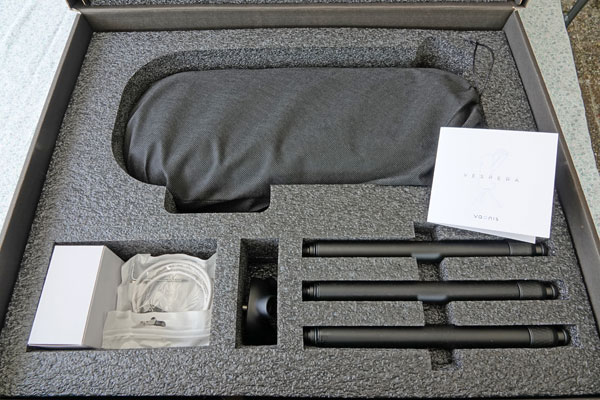 |
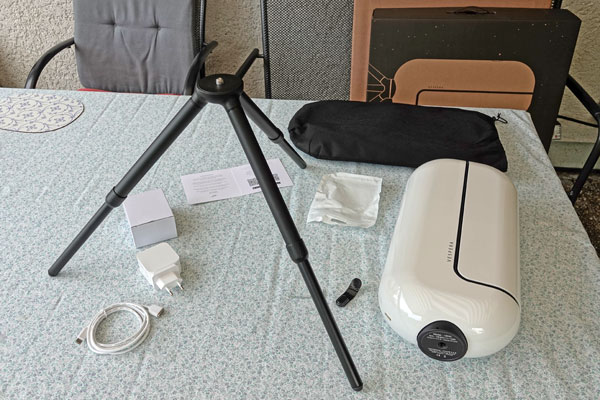 |
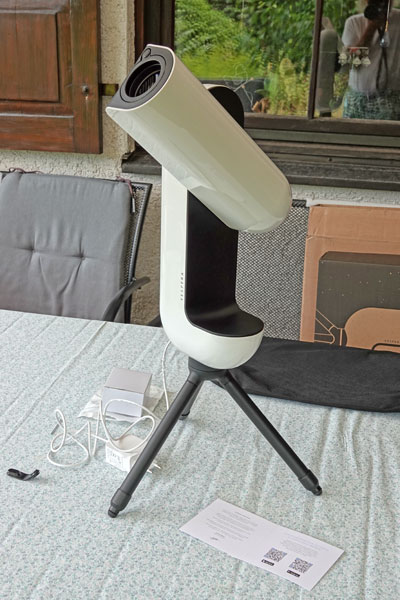 |
Photo: My Vaonis Vespera (end of July 2022)
After a little more than half year with the Vaonis Vespera (end of February 2023), I would like to try to draw first conclusions. First of all, I am happy to have "jumped on the Vespera bandwagon" and to have purchased the Vespera at a significantly lower price during the Kickstarter campaign. Second, my judgment on the Vespera is inevitably influenced by what I have experienced with the original Unistellar eVscope and the eVscope 2. And so, in these first conclusions, I will keep making comparisons with the eVscope (2).
Image Quality
The image quality of the Vaonis Vespera is significantly better than that of Unistellar's various eVscope versions. As a refractor, the Vespera shows (mostly...) clean round stars and also no spikes for big stars as the eVscope does, which is a Newtonian telescope; spikes are surely a matter of personal taste...
But like the eVscope, the Vespera shows "traces" that may originate from field rotation (walking pattern noise?) and can disturb the image impression.
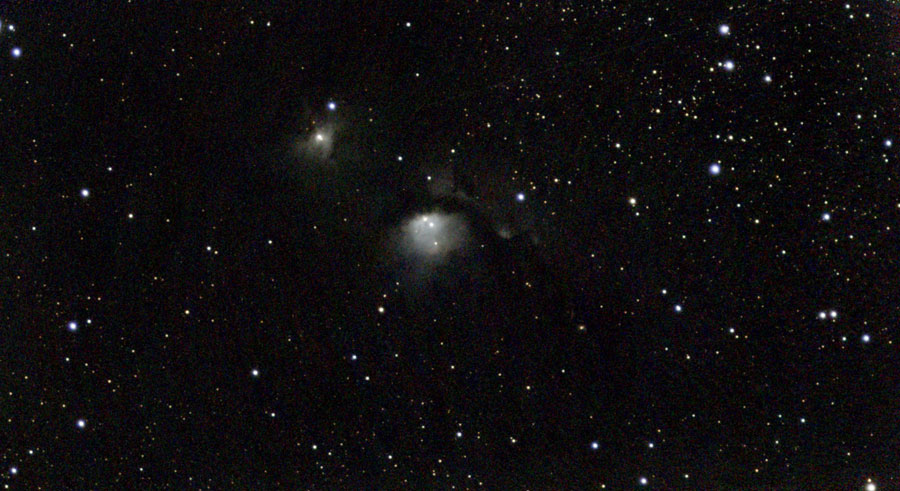 |
M 78, Feb 7, 2023 - original, 2120s |
Photo: This photo of M 78 demonstrates the "traces" that I mention above (open the original!)
Unlike the eVscope, whose images do not improve over time (after about 5 minutes; according to my experience and test reports), the Vespera images become brighter and more detailed over time (you can watch this as an animation or you can create an animation from the stack photos (JPEG), provided you savend them). For image examples, see page Photo Comparison Vaonis Vespera versus Unistellar eVscope (2) - Part 3.
Unfortunately, the stars also "grow" in the process, so they become more distracting over time (with the eVscope, the stars stop growing after the "initial" phase). I found the stars in my photos too big from the beginning, especially when I compared them with sample photos from Vaonis. Vaonis also confirmed this when I questioned them about this difference:
- I showed your picture to the technical team and I received confirmation that your stars are slightly bigger than from our website because we have post-treated them to enhance the contrast as well as to limit the star spread.
- You should try post-treating your stars too when you post-process your images.
In other words, you only get the stars smaller by post-processing them accordingly (this should perhaps be noted for the photos published by Vaonis...). I read that this would be possible with, for example, GIMP, but have not done anything in this direction so far. Recently, however, I have found an easier, but more expensive way to get smaller stars: the Dual Band filter attenuates stars significantly (the Light Pollution filter does not seem to attenuate stars); however, with my typical post-processing (brightening), they are somewhat enhanced again, as the photos below demonstrate:
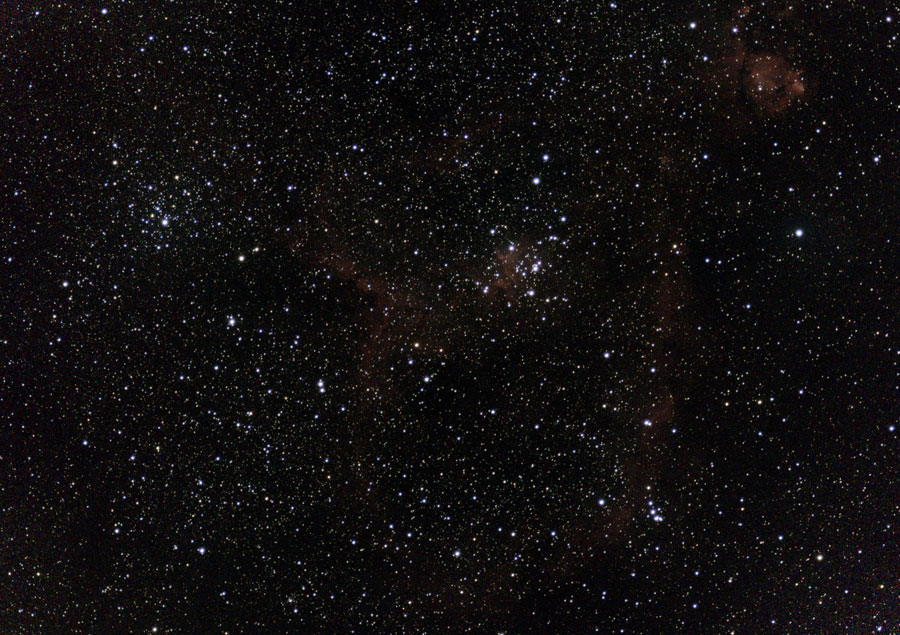 |
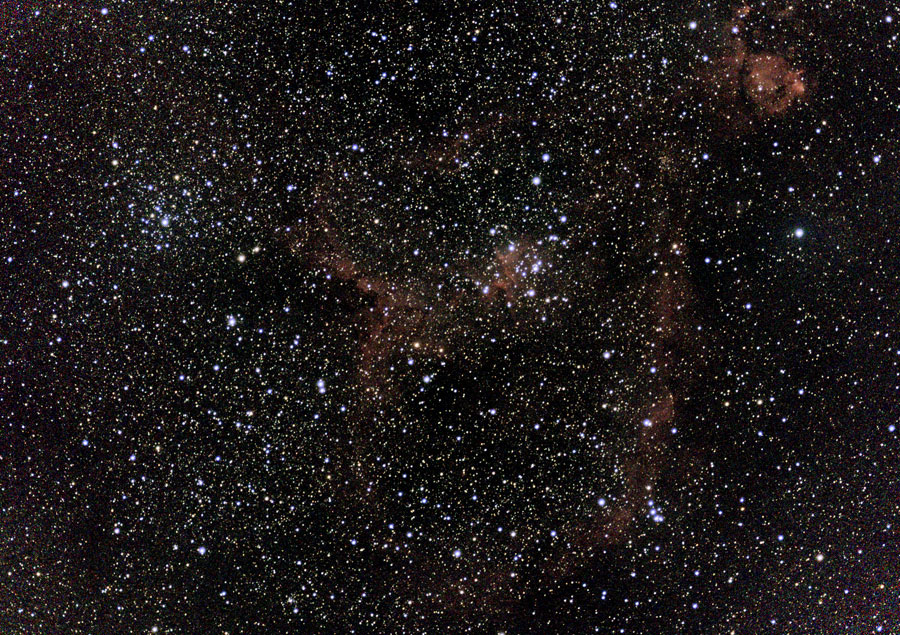 |
|
IC 1805, Nov 1, original, 3750s, mosaic |
IC 1805, Nov 1, large, photo left processed |
|
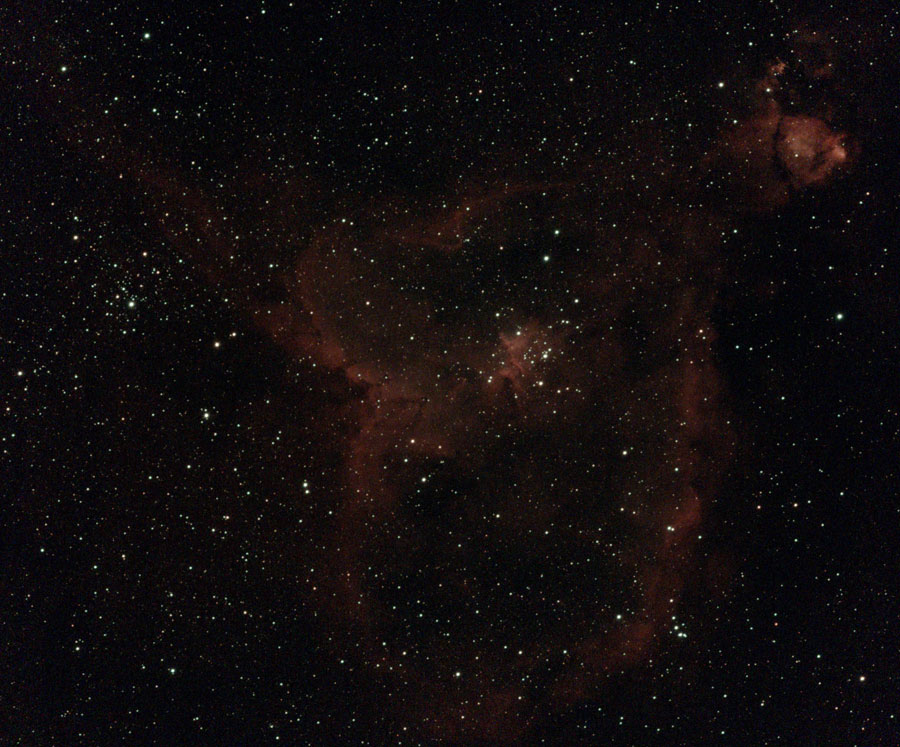 |
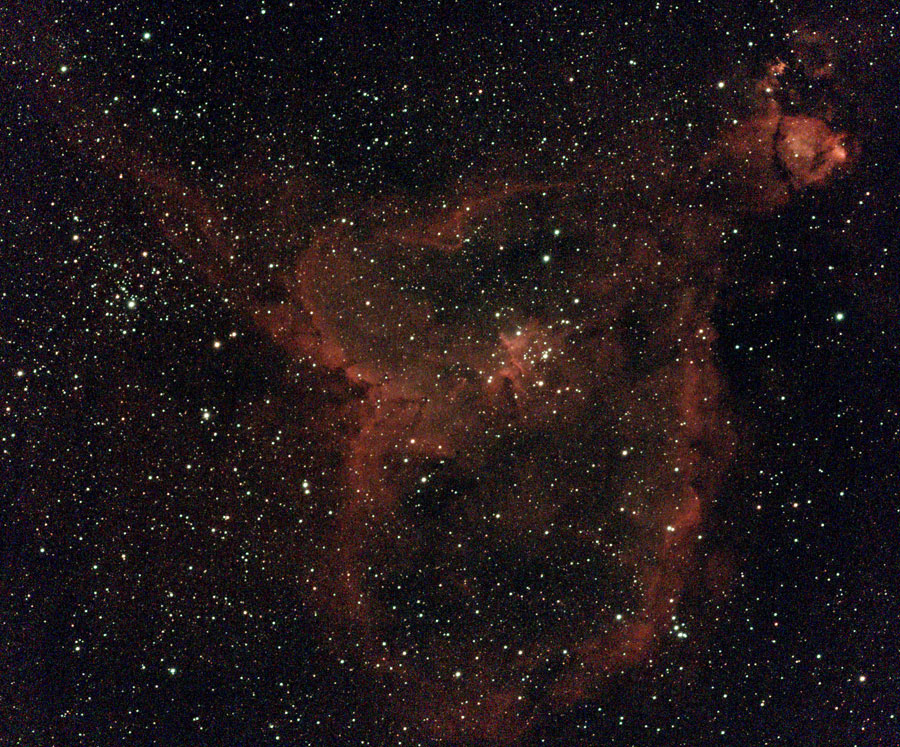 |
|
IC 1805, Feb 20, 2023 - original, 3270s, mosaic, Dual Band Filter |
IC 1805, 20.2.2023 - large, photo left processed |
Photos: Examples for the suppression of stars by the Dual Band Filter and making them more visible through my post-processing (brightening the image up)
In my eyes, the colors look better or more "natural" with the Vespera than with the eVscope, but colors are of course "a matter of personal taste" in astronomy photos. If you take the photos with a filter, the colors are shifted in certain directions anyway, depending on the transmission behavior of the filter used.
See, for example, page Photo Comparison Vaonis Vespera versus Unistellar eVscope (2).
All in all, the Vespera photos already look much more like "astrophotography" to me than the eVscope photos, especially in the examples processed by Vaonis (you cannot expect to achieve similar feats yourself...). Of course, they are still "miles away" from real astronomy photos, but I like the results that I get with the Vespera!
Image Size
Field of View
The Vaonis Vespera offers a field of view of 1.6° x 0.9° at 1920 x 1080 pixels (HD format). However, since the Singularity app keeps cropping the image as the observation progresses (probably mainly due to field rotation), the end result often has noticeably fewer pixels (this is why the object seems to grow in the animation of the image stack; in reality, it remains constant in size, but the image gets smaller). I am not a fan of the HD format. Of course, I might crop the photos to other formats.
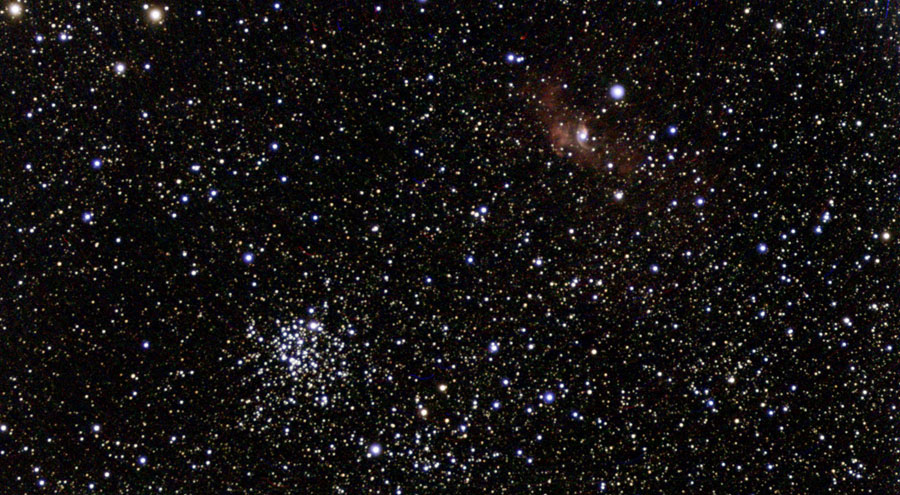 |
M 52 and NGC 7635, Aug 25, 2022 - original (94 frames = 940 s) |
Photo: Example of the field of view/image size of the Vespera - demonstrating the advantage that two DSO can be observed in parallel
Mosaic Mode
Since the mosaic mode (covalENS) is available for the Vespera, one can resize the image format to different sizes (up to 4 times the original format*), including a square format. In addition, you can rotate the image field, so that you can better place objects individually or together in the image field. It is almost like being able to rotate the camera.... In my eyes, the mosaic mode is a real "game changer", because it opens up completely different shooting possibilities in the "rich-field area". On the other hand, the objects themselves become much smaller than with the eVscope; what was already too small there becomes even smaller. Thus, many small targets (especially small planetary nebulae and galaxies) drop out for the Vespera because they become too unattractive. Well, you cannot have everything at once!
*) The objects themselves get exactly the same size in mosaic mode as in normal acquisition mode, only the field of view is changed.
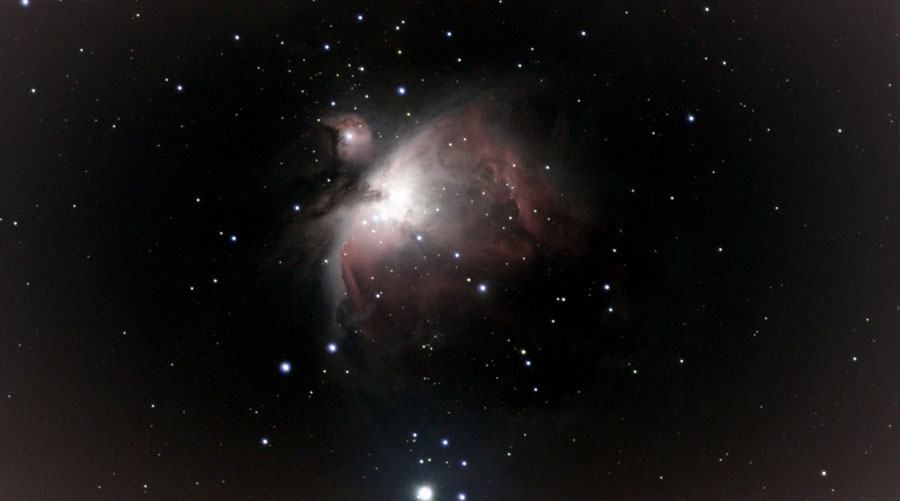 |
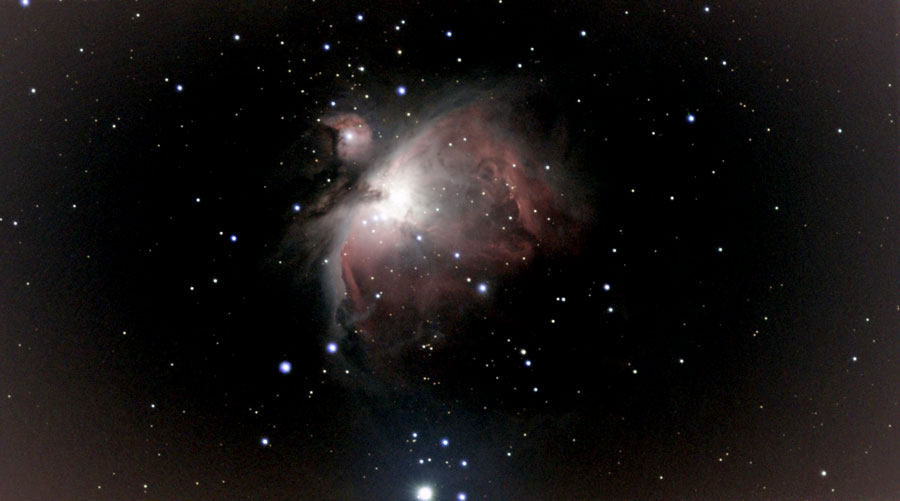 |
|
M 42/43, Jan 18, 2023 - original, 640s |
M 42/43, Jan 18, 2023 - large, 640s, processed |
|
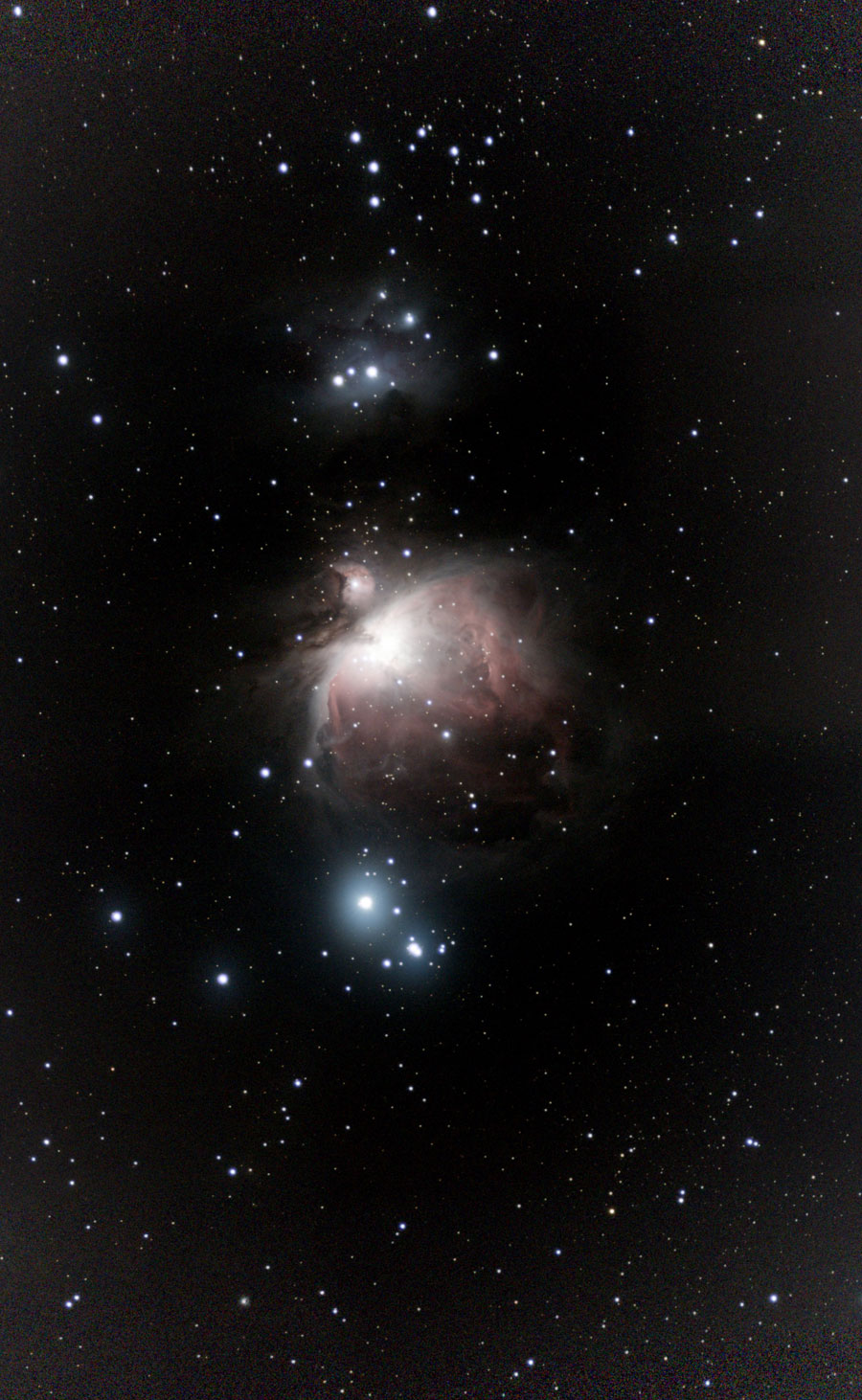 |
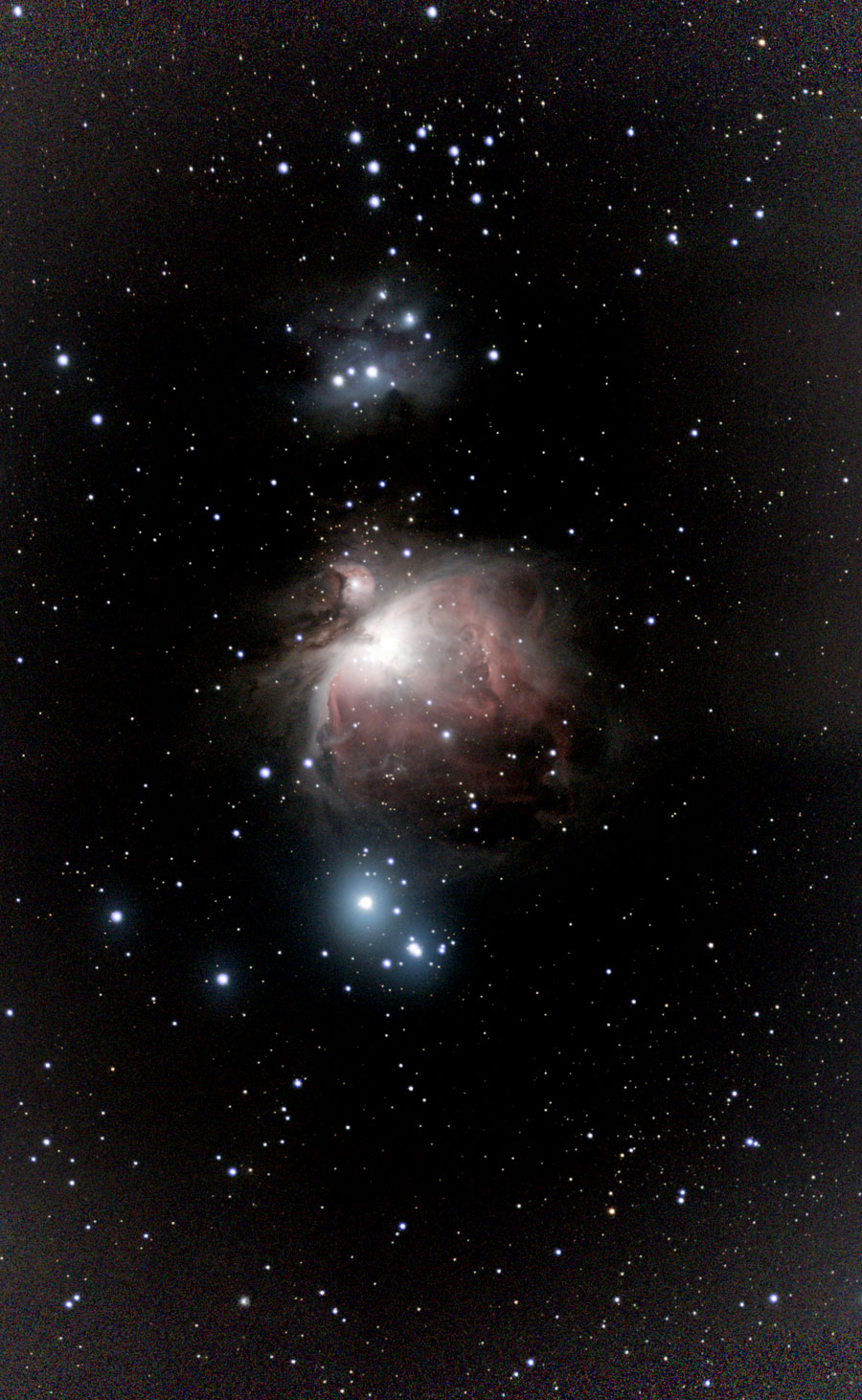 |
|
M 42/43 with NGC 1977, NGC 1980, and NGC 1981, Jan 18, 2023 - original, 2410s, mosaic |
M 42/43 with NGC 1977, NGC 1980, and NGC 1981, Jan 18, 2023 - large, 2410s, processed |
Photos: Examples of a regular photo and a photo in mosaic mode
For more information on the mosaik mode see page Mosaic Mode.
It should be mentioned that the mosaic mode drastically increases the observation times (about 40-60 min for one run, 2 and more runs for better results).
Also, the "tracks" (walking pattern noise)* possibly caused by field rotation seem to be less pronounced (i.e. better "removed") with mosaics.
However, with about the same exposure time, a "normal" image is brighter, less noisy, and shows more details than a mosaic (see the photos below), so I guess that I cannot recommend using the mosaic mode generally, expecially because exposure times, as already mentioned, are longer for mosaics.*
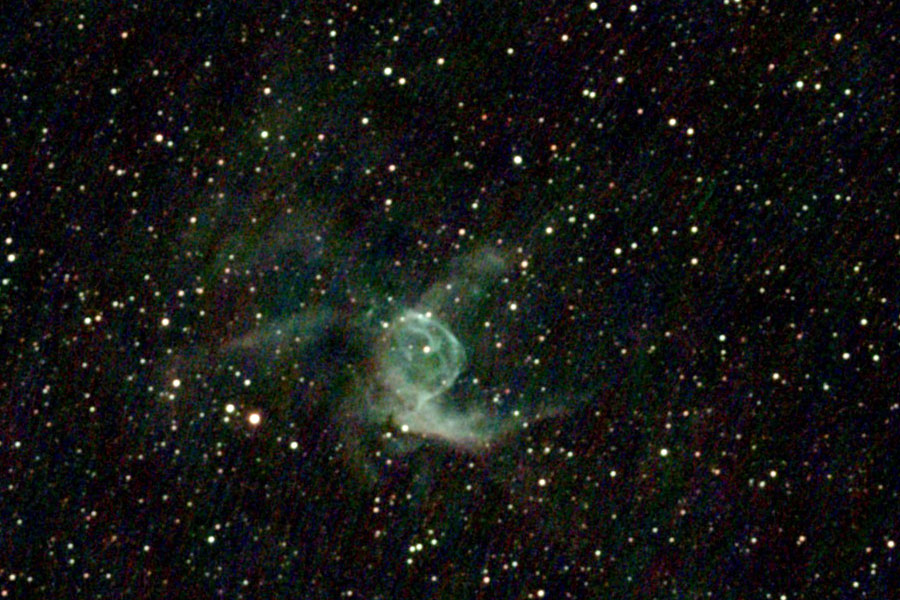 |
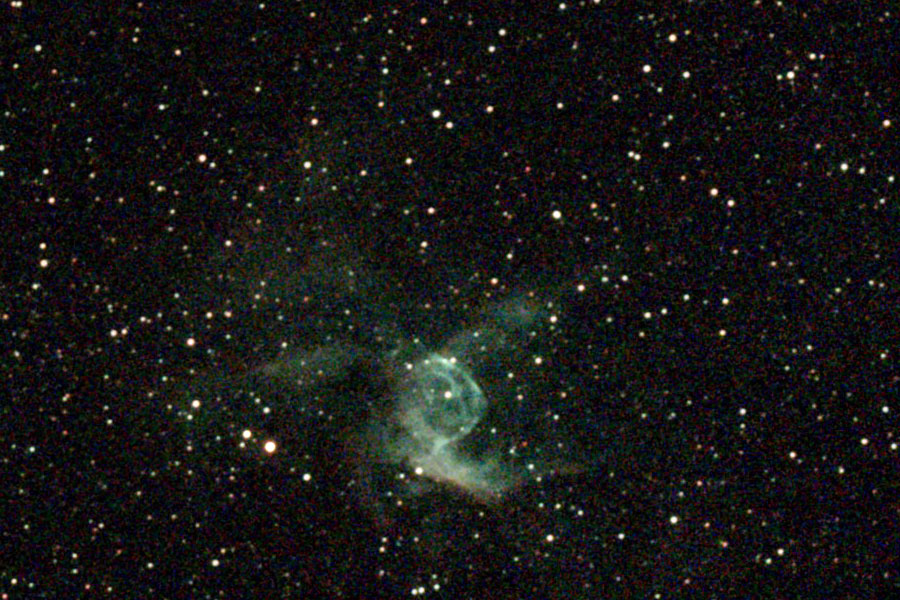 |
|
NGC 2359 - Feb 20, 2023, 1830s, Dual Band Filter, section |
NGC 2359 - Feb 20, 2023, 1960s, mosaic, Dual Band Filter, section |
Photos: Sections of photos, to demonstrate the different field rotation traces for "normal" photos and for mosaics (click the previews for larger versions)
*) My impression that walking pattern noise is lower in Mosaic mode was confirmed by a review of the Vespera on the Astroshop website:
- ... the latest features, such as the mosaic mode, which makes it possible to photograph larger objects and improve the image quality through dithering, make perfect sense (translated).
I therefore asked Vaonis on May 23, 2023 whether dithering is used with the Mosaic mode and whether Mosaic mode should be used in general:
- Finally, I have a question regarding CovalENS. In a review of the Vespera on astroshop.de, I found the statement that CovalENS uses dithering to reduce "walking pattern noise". I ask this, because I myself had the impression that mosaics do have less noise of this kind. Can you please comment on this?
- One might be tempted to recommend to always use the mosaic mode instead of the normal mode, but my impression is that the "normal" photos look a little better than mosaics of the same exposure time...
Vaonis answered (May 24, 2023):
- You are right, dither observation are done with Mosaic Mode. In classic mode (stacking), the dither is negligible. Nevertheless, since Vespera has no de-rotator, there is a "natural" rotating dithering.
However, you can't control the dithering during Mosaic Mode. - Depending on your mosaic field of view, it will take longer to achieve the same results compared to a classic observation as the stacking and the field of view coverage is not done the same.
See also appendix 2!
Design versus Handling
The Vespera looks a bit like as if it were designed by Apple, including a magnetic socket for the power supply. It is small, but at 5 kg it feels heavy for its size and is top-heavy. I find the Vespera a bit cumbersome to carry around and attach to the tripod, especially because of the swivel arm. The Vesperea can easily slide out of your hands, particularly when the swivel arm turns away. If the Vespera were not such a "design object," perhaps a handle, grip, or other aid would have been added that would make it easier to carry and handle the scope...
Magnetic Socket, Circular Bubble
And I also have my problems with the power supply's magnetic socket when connecting the power supply to the Vespera; I have to get on the ground for this... A "highlight" for me in the negative sense is also the circular bubble that can be magnetically attached to the socket for the power supply. Every time I touch the Vespera, I touch it, and it falls off. This will probably be the first part I will lose... It would have been nice in a practical, not in a design sense, if Vaonis had added some kind of compartment for the circular bubble in the case, where you can store it safely and find it easily.
(Adjustable) Tripod
I have also problems with the adjustable tripod that was part of the Adventurer Pack. I have a hard time screwing the three legs into the tripod head (thread pitch too flat?) and also screwing the head with legs onto the Vespera (I lay the Vespera flat as recommended by Vaonis). I therefore purchased a Rollei quick release adapter (something similar is available from Vaonis at multiple times the price...), but am not really happy with it either (inserting it with the top-heavy Vespera is somewhat "tricky").
On/Off Switch
Vaonis writes that you do not have to press the on/off switch, and that a touch is enough to activate it. I can confirm this, but also in a negative sense, because whenever I touch the Vespera, I unintentionally also touch the power button and turn the device on. When I do not notice this, the device may suck the battery dry (it probably shuts off after a certain amount of time when not in use)...
Observing with the Vespera
Observing, Singularity Software
While the eVscope offers an electronic viewfinder on some models, Vaonis promoted observing via smartphone/tablet from the beginning. The latter runs the control software, and I only know the Singularity app, not the previous version. This app is a bit more extensive than the initial app from Unistellar (in the meantime, there is also a new and more extensive app in version 2 there). I definitely get along well with the app and think others will too. I find Singularity to be much more stable than the Unistellar app, where crashes are still commonplace and you can often only get further if you abort the app and restart it.
WiFi Range
My main problem with the Vespera/Singularity combo are WiFi range issues, even if they are not yet indicated by the app. In such a case, the app suddenly jumps back in time and shows an older observation state. To return to the current state, I approach the Vespera until it updates the observation state again. By the way, I do the same when WiFi range problems are indicated. Overall, the WLAN range of the Vespera seems to be somewhat better than that of the eVscope, where I basically cannot observe "from the kitchen" at all (the telescope is on the terrace). This is possible with the Vespera, if you are willing to approach the telescope and reconnect when the range fluctuates (this is how I do it with the eVscope as well, but much more often...).
Duration or "Style" of Observation
While you are "done" with the eVscope at 5 minutes observation time and hardly any improvements are to be expected (star clusters are already "done" sooner), Vaonis recommends observation times for objects that are in the catalog - and these start at 15 minutes and reach sometimes 2 hours for nebulae. Initially, I was too curious to wait for the recommended observation time and observed with shorter durations...
Mainly because of this difference, you can sometimes observe 20 and more DSO in the evening with the eVscope, while with the Vespera it is rather less than 10, and maybe only 1-2. Overall, everything is slower with the Vespera than with the eVscope (the Vespera moves quite slowly, but makes little noise!). So in my eyes the Vespera provides a very different observing experience. And I think that the eVscope is better suited to demonstrating DSO to other people than the Vespera, because their patience is usually "exhausted" after a few minutes per object.... However, with Vespera you can see something even after a few minutes to show it to others, but it is usually far from the desired final state...
Observation Targets
When I was only observing visually, I was mainly looking for open and globular star clusters, because these were easiest to find with visual telescopes. Only larger nebulae and galaxies (and the moon) were also easily accessible. With the eVscope I observed pretty much everything that came in front of the telescope. I find the field of view of the original eVscope well chosen, even if the moon unfortunately does not fit into the picture completely. Many planetary nebulae and also some planets remain small dots, as well as small globular star clusters and galaxies. On the other hand, many nebulae are too large for the field of view, and you aim somehow "in the middle" without having a clear idea what you are supposed to see...
With the Vespera, it quickly became clear to me that it is more of a "nebula telescope". However, many nebulae are too large for the original field of view, and only the mosaic mode opens up more nebulae and other targets, especially multiple objects. Objects that are already somewhat small in the eVscope are even more so in the Vespera and are not worth observing (in my opinion...). And since observing with the Vespera is much slower and you have to choose longer observation times, especially for mosaics, it does not hurt if the selection of possible targets is a bit more limited...
Obstacles
If objects are not found, there are probably obstacles such as houses or trees in the way. But it can also happen during the observation that the object gets hidden behind obstacles, because it moves over time, or suddenly clouds appear. It is difficult for me with the Vespera to see if there are obstructions in the image field. Since the corresponding photos are "sorted out" and do not end up on the stack, I do not even see that or whether there is something in the way! A practical feature would be an option that allows you to see the shot itself (as can be saved as a FITS file) that allows you to switch the view between direct observation and the image stack.
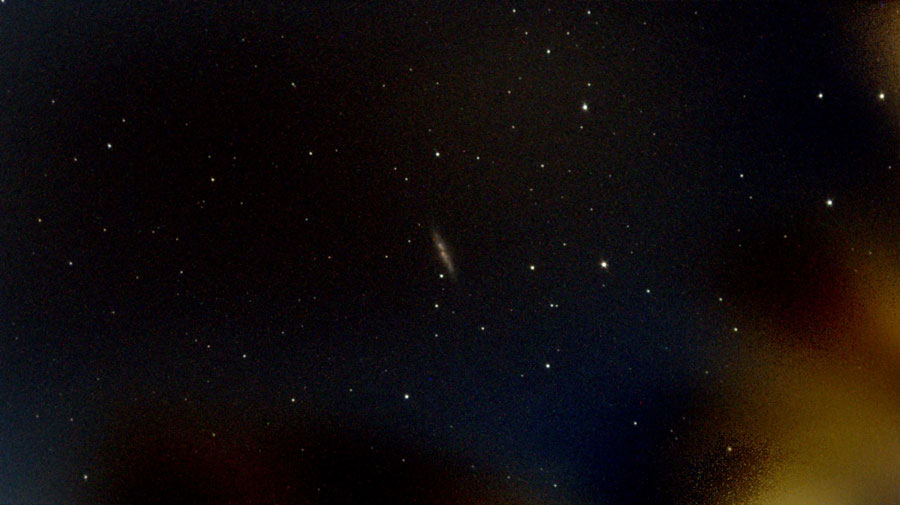 |
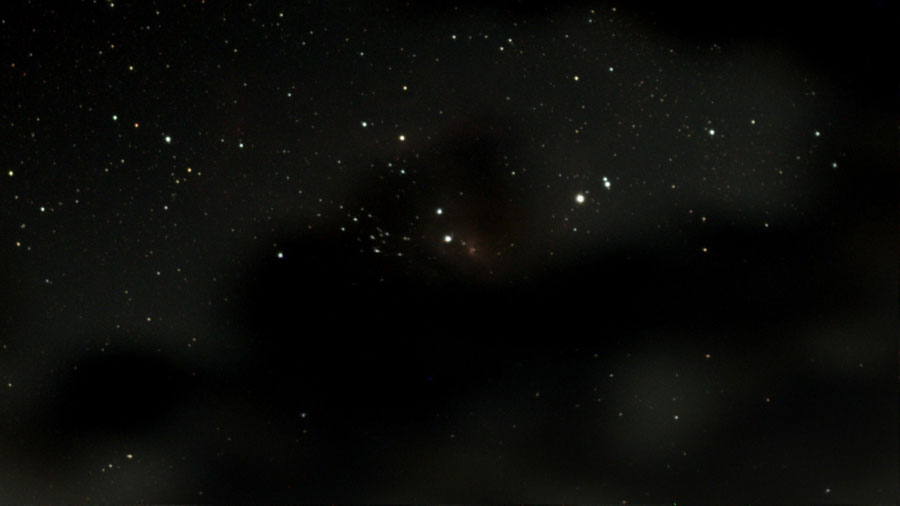 |
|
M 82 - original, 120s; obstacles |
M 8 - original, 30s; obscured |
Photos: Examples of obstacles...
Further Problem Areas...
Initialization
The Vespera also has its problems, and these are partly due to the Vaonis concept of automating operation as much as possible. One example is the initialization, where the telescope orients itself in the sky. While you have to manually move the eVscope to a position where it will find alignment stars, the Vespera opens its arm in the direction you put it on the ground and then automatically tries to find a favorable position for the alignment - and this often goes wrong because there are no fitting stars to be found or there is an obstacle that covers the sky. Often enough the Vespera aborted its initialization without a result, because it encountered clouds or obstacles. Vaonis gave me the tip to turn the Vespera in such a way that it encounters stars when raising the arm. So this is how I will initialize "semi-automatically" in the future.
By the way, with the eVscope, you can watch what it "sees" when it is aligned; unfortunately, that is not the case with the Vespera, you can only guess by "eye". If you could observe what Vespera "sees" during the initialization, you might be able to abort sooner and restart the initialization.
Autofocus (AF)
The autofocus (AF) is another problem area for me. On the one hand, the adjustment of the AF itself takes a bit long, on the other hand, the autofocus does not set the focus correctly every now and then, but I am only able to realize this when a target has been observed. It therefore would be helpful to get some kind of visual feedback on the current state of the AF (for example, the recorded image) and not just a percentage of how far the Vespera got along with the adjustment.
Also, I have found that the focus often gets misaligned over time. It seems therefore advisable to renew the AF before each observation (which again takes time...), particularly since observations can last quite long. So far, to renew the AF, I first have to approach a target with the Vespera, interrupt the observation, update the AF and approach the target again. It would be more convenient if there was a "GoTo with AF" functionality so that the observation would not have to be aborted first.... This could be realized, for example, by "donating" a "renew AF" checkbox to the GoTo command.
Update: At the end of March 2023, Vaonis introduced the AcutENS technology via a software update, which adjusts the autofocus dynamically, i.e., during observation. This should actually make focus problems a thing of the past. However, I have only had little opportunity to try this out and can therefore not report any experiences.
Final Words
I am happy to have purchased the Vaonis Vespera and to be able to record photos in better quality than with the eVscope. However, I still have to get used to the slower observing speed... Maybe it would be a good idea to build up a visual telescope in parallel to better use the observation time (and also the visual telescope).
Note: See also my Singularity Wish List in the appendix!
Note: In June 2024, I sold my Vaonis Vespera smart telescope. I therefore cannot report any further experiences with it here. |
Links
- Vaonis: vaonis.com/fr (FR), vaonis.com (EN)
- Vespera Kickstarter campaign: www.kickstarter.com/projects/vaonis/vespera-the-new-way-to-observe-the-universe/description
- Vespera/Stellina comparison page: vaonis.com/stellina-vs-vespera (EN)
- Vespera FAQ: support.vaonis.com/portal/en/kb/faq/vespera (EN)
- See also my page offering Astronomy Links.
Appendix: Singularity Wish List
Since nothing can be changed on the Vespera itself in the short term, my wish list refers to the Singularity app.
GoTo that Automatically Renews Autofocus at the Beginning of an Observation (Obsolete)
> "Live Focus" (AcutENS) solves the issue.
I have made the experience that the focus of the Vespera often gets misaligned in the course of time. It therefore seems advisable to renew the AF before each observation (which again costs time...), particularly since observations can last quite long. So far, to renew the AF I first have to approach a target with the Vespera, interrupt the observation, update the AF and approach the target again. It would be more convenient if there was a "GoTo with AF" functionality so that the observation would not have to be aborted first.... This could be realized, for example, by "donating" a "renew AF" checkbox to the GoTo command.
Visualization of the Autofocus Setting (Obsolete?)
> "Live Focus" (AcutENS) probably solves this issue.
Speaking of autofocus, it would be instructive to get some sort of visual feedback about the current state of the AF (for example, the photo taken) and not just a percentage of how far along the Vespera got along with setting the AF.
Switching Option Between the View of the Image Stack and the Directly Captured Images (Live View) During Observations
During an observation, it can happen that the object is suddenly hidden behind obstacles because it moves over time - or it is obscured by clouds that suddenly appeared. With the Singularity app, it is difficult for me to tell whether there are obstructing objects in the field of view. Since the corresponding photos are "sorted out" and do not end up on the stack, I do not even see that or whether something is in the way! I would find it practical to have a way to see the directly captured images themselves (as they can be saved as FITS files) by allowing to switch between direct observation (live view) and image stack view.
Show the Actually Captured Image During Initialization and GoTo
The Singularity app lets the user "blind" as to its internal processes during initialization and GoTo. I would rather have the user know what the Vespera is currently "seeing". This is not only useful in the case of problems (obstacles, clouds), but also does not get boring as fast (for me, the animated texts during GoTo quickly became boring...).
Notes
Most of my suggestions relate to being better informed about the internal processes of the Vespera and to be able to intervene if necessary. As it is designed, however, Vespera is rather a "fully automatic system" in which the user should and can intervene as little as possible. In this respect, I hardly believe that my suggestions will meet with open ears from the developers of Vespera...
To bring the whole thing together, one could for example introduce an "expert mode", where the suggestions are implemented, while the Vespera behaves in the "beginner mode" as before. Alternatively, one could offer each of these functions as an option in the settings (except for automatic AF for GoTo).
Appendix 2: Letter to Vaonis (Two proposals for the Singularity app and a question... May 23, 2023)
Dear Vaonis Team,
First, I would like to say "thank you" for creating the Vespera smart telescope. Being also an eVscope* owner (first the original one, now the eVscope 2), I found that the Vespera delivers much better image quality, offers CovalENS as a real "game changer", but also requires much more patience than the eVscope. Thus, observing with the Vespera is quite a different thing than observing with the eVscope. And I do not think that it is well suited to demonstrating your observations live to other people (who typically loose interest in an observation after about 3 minutes...).
*) It looks as if Unistellar and Vaonis ignore each other. I do not know why...
Some time ago, I created a page on my Website with preliminary conclusions and a short wish list for the Singularity app (http://www.waloszek.de/astro_va_vespera_faz1_e.php). In part, it is already obsolete thanks to updates to the Singularity app. Here are two still relevant proposals from my wish list:
(1) Switching Option Between the View of the Image Stack and the Directly Captured Images (Live View) during Observations
During an observation, it can happen that the object is suddenly hidden behind obstacles because it moves over time - or it is obscured by clouds that suddenly appeared. With the Singularity app, it is difficult for me to tell whether there are obstructing objects in the field of view. Since the corresponding photos are "sorted out" and do not end up on the stack, I do not even see that or whether something is in the way! I would find it practical to have a way to see the directly captured images themselves (as they can be saved as FITS files) by allowing the user to switch between direct observation (live view) and image stack view.
(2) Show the Actually Captured Image During Initialization and GoTo
The Singularity app lets the user "blind" as to its internal procedures during initialization and GoTo. I would rather have the user know what the Vespera is currently "seeing". This is not only useful in the case of problems (obstacles, clouds), but also does not get boring as fast as the text animations (for me, the animated texts during GoTo quickly became boring...).
Comments
My suggestions relate to being better informed about the internal processes of the Vespera and to be able to intervene if necessary. As it is designed, however, the Vespera is rather a "fully automatic system" in which the user should and can intervene as little as possible. In this respect, I hardly believe that my suggestions will meet with open ears from the developers of the Singularity app...
To bring the whole thing together, one could, for example, introduce an "expert mode", where the suggestions are implemented, while the Vespera behaves in the "beginner mode" as before.
Alternatively, one could offer these functions as an option in the settings.
A Question
Finally, I have a question regarding CovalENS. In a review of the Vespera on astroshop.de, I found the statement that CovalENS uses dithering to reduce "walking pattern noise". I ask this, because I myself had the impression that mosaics do have less noise of this kind. Can you please comment on this?
One might be tempted to recommend to always use the mosaic mode instead of the normal mode, but my impression is that the "normal" photos look a little better than mosaics of the same exposure time...
Once again, thank you for creating the Vespera and the Singularity app!
Best regards, Gerd Waloszek (owner of the Vespera and the eVscope 2 (and much more...))
Answer from Agnès Dailly, Technical & Client Support Manager, Vaonis
Dear Gerd,
Thank you for your very kind and constructive feedback.
We're very happy that you enjoy your Vespera among other instruments!
I have escalated your feedback to the technical team.
I can't promise or guarantee that it will be implemented but at least they've been made aware of your comments.
You are right, dither observation are done with Mosaic Mode. In classic mode (stacking), the dither is negligible. Nevertheless, since Vespera has no de-rotator, there is a "natural" rotating dithering.
However, you can't control the dithering during Mosaic Mode.
Depending on your mosaic field of view, it will take longer to achieve the same results compared to a classic observation as the stacking and the field of view coverage is not done the same.
I stay at your disposal if you require any further information.
Kind regards,
Agnès Dailly
Technical & Client Support Manager
VAONIS
| 24.06.2024 |